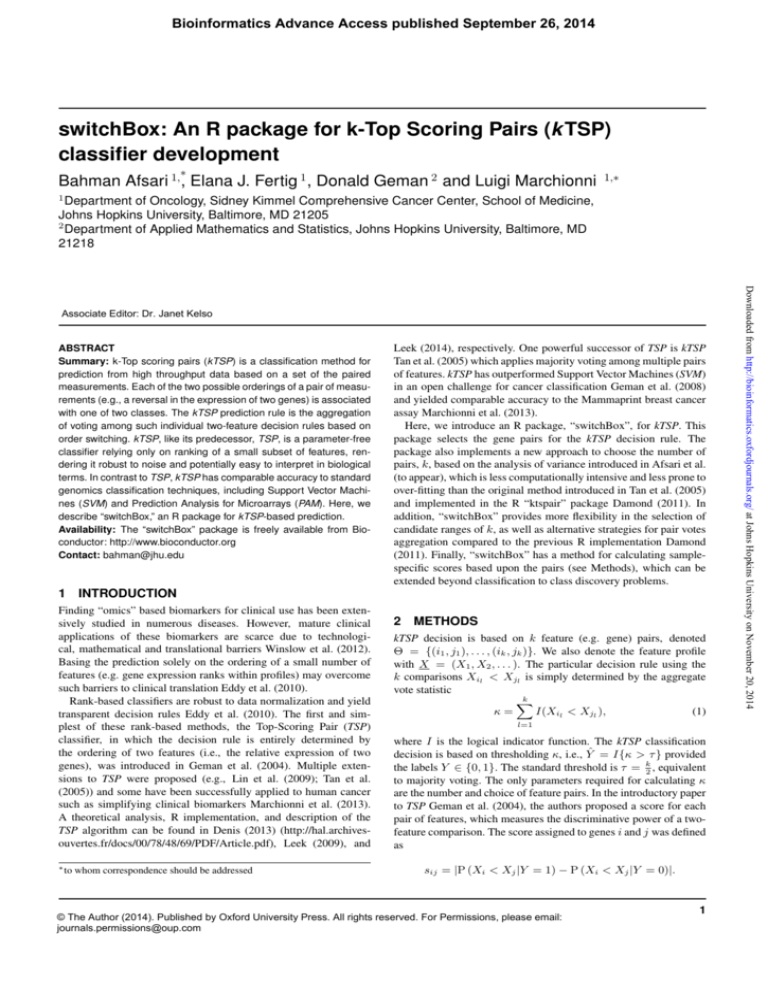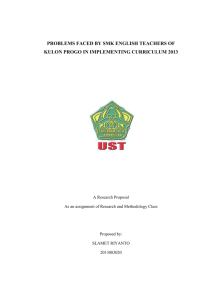
Bioinformatics Advance Access published September 26, 2014
switchBox: An R package for k-Top Scoring Pairs (k TSP)
classifier development
∗
Bahman Afsari 1, , Elana J. Fertig 1 , Donald Geman 2 and Luigi Marchionni
1,∗
1
Department of Oncology, Sidney Kimmel Comprehensive Cancer Center, School of Medicine,
Johns Hopkins University, Baltimore, MD 21205
2
Department of Applied Mathematics and Statistics, Johns Hopkins University, Baltimore, MD
21218
ABSTRACT
Summary: k-Top scoring pairs (kTSP) is a classification method for
prediction from high throughput data based on a set of the paired
measurements. Each of the two possible orderings of a pair of measurements (e.g., a reversal in the expression of two genes) is associated
with one of two classes. The kTSP prediction rule is the aggregation
of voting among such individual two-feature decision rules based on
order switching. kTSP, like its predecessor, TSP, is a parameter-free
classifier relying only on ranking of a small subset of features, rendering it robust to noise and potentially easy to interpret in biological
terms. In contrast to TSP, kTSP has comparable accuracy to standard
genomics classification techniques, including Support Vector Machines (SVM) and Prediction Analysis for Microarrays (PAM). Here, we
describe “switchBox,” an R package for kTSP-based prediction.
Availability: The “switchBox” package is freely available from Bioconductor: http://www.bioconductor.org
Contact: bahman@jhu.edu
1
INTRODUCTION
Finding “omics” based biomarkers for clinical use has been extensively studied in numerous diseases. However, mature clinical
applications of these biomarkers are scarce due to technological, mathematical and translational barriers Winslow et al. (2012).
Basing the prediction solely on the ordering of a small number of
features (e.g. gene expression ranks within profiles) may overcome
such barriers to clinical translation Eddy et al. (2010).
Rank-based classifiers are robust to data normalization and yield
transparent decision rules Eddy et al. (2010). The first and simplest of these rank-based methods, the Top-Scoring Pair (TSP)
classifier, in which the decision rule is entirely determined by
the ordering of two features (i.e., the relative expression of two
genes), was introduced in Geman et al. (2004). Multiple extensions to TSP were proposed (e.g., Lin et al. (2009); Tan et al.
(2005)) and some have been successfully applied to human cancer
such as simplifying clinical biomarkers Marchionni et al. (2013).
A theoretical analysis, R implementation, and description of the
TSP algorithm can be found in Denis (2013) (http://hal.archivesouvertes.fr/docs/00/78/48/69/PDF/Article.pdf), Leek (2009), and
∗ to
Leek (2014), respectively. One powerful successor of TSP is kTSP
Tan et al. (2005) which applies majority voting among multiple pairs
of features. kTSP has outperformed Support Vector Machines (SVM)
in an open challenge for cancer classification Geman et al. (2008)
and yielded comparable accuracy to the Mammaprint breast cancer
assay Marchionni et al. (2013).
Here, we introduce an R package, “switchBox”, for kTSP. This
package selects the gene pairs for the kTSP decision rule. The
package also implements a new approach to choose the number of
pairs, k, based on the analysis of variance introduced in Afsari et al.
(to appear), which is less computationally intensive and less prone to
over-fitting than the original method introduced in Tan et al. (2005)
and implemented in the R “ktspair” package Damond (2011). In
addition, “switchBox” provides more flexibility in the selection of
candidate ranges of k, as well as alternative strategies for pair votes
aggregation compared to the previous R implementation Damond
(2011). Finally, “switchBox” has a method for calculating samplespecific scores based upon the pairs (see Methods), which can be
extended beyond classification to class discovery problems.
whom correspondence should be addressed
2
METHODS
kTSP decision is based on k feature (e.g. gene) pairs, denoted
Θ = {(i1 , j1 ), . . . , (ik , jk )}. We also denote the feature profile
with X = (X1 , X2 , . . . ). The particular decision rule using the
k comparisons Xil < Xjl is simply determined by the aggregate
vote statistic
k
X
κ=
I(Xil < Xjl ),
(1)
l=1
where I is the logical indicator function. The kTSP classification
decision is based on thresholding κ, i.e., Ŷ = I{κ > τ } provided
the labels Y ∈ {0, 1}. The standard threshold is τ = k2 , equivalent
to majority voting. The only parameters required for calculating κ
are the number and choice of feature pairs. In the introductory paper
to TSP Geman et al. (2004), the authors proposed a score for each
pair of features, which measures the discriminative power of a twofeature comparison. The score assigned to genes i and j was defined
as
sij = |P (Xi < Xj |Y = 1) − P (Xi < Xj |Y = 0)|.
© The Author (2014). Published by Oxford University Press. All rights reserved. For Permissions, please email:
journals.permissions@oup.com
1
Downloaded from http://bioinformatics.oxfordjournals.org/ at Johns Hopkins University on November 20, 2014
Associate Editor: Dr. Janet Kelso
The first training algorithm proposed for training kTSP, i.e., for
finding Θ, was an ad-hoc method based on the score Tan et al.
(2005).
The “switchBox” package implements a formal method of feature selection based on analysis of variance Afsari et al. (to appear).
Briefly, this method selects the feature pairs maximizing the distance between the expectation of κ in each group normalized by the
variance. The target set of feature pairs is then
Θ∗ = arg max p
Θ
E (κ(Θ)|Y = 1) − E (κ(Θ)|Y = 0)
. (2)
Var (κ(Θ)|Y = 1) + Var (κ(Θ)|Y = 0)
3
IMPLEMENTATION
For computational efficiency and speed, “switchBox” calculates the
score between all feature pairs using C routines. The user can directly calculate the score of a desired set of features or feature pairs
by invoking SWAP.CalculateSignedScore function.
The package provides a training function (SWAP.KTSP.Train)
for the classifier and a function (SWAP.KTSP.Classify)
for predicting the label of an unseen sample. The training
function allows the user to filter either the individual features or the feature pairs, thereby reducing the variability in the
learned decision rules. The package also provides a function
(SWAP.CalculateSignedScore) to calculate the pairwise
scores from any subset of features or subset of feature pairs.
Below we briefly show how to train a kTSP classifier for breast
cancer recurrence within five years using gene expression data from
Marchionni et al. (2013), described in further detail in the “switchBox” package vignette. First, we load the example training and
testing gene expression data contained in the “switchBox” package
We then train the classifier and compute the confusion matrix for
predictions on the test samples as follows:
data(matTraining) #Loading training data
heatmap(1*kappa$comparisons, scale=”none”, labRow=trainingGroup)
4
CONCLUSION
We introduced “switchBox,” an R package for kTSP classifier with a
robust procedure for pair selection as previously described in Afsari
et al. (to appear). As mentioned in Afsari et al. (to appear), the procedure requires less computation and is less prone to overfitting than
the one described in Tan et al. (2005) and implemented in “ktspair”
package Damond (2011). Moreover, we provide functions for calculating auxiliary statistics as well as any user-defined combination of
the comparisons.
Acknowledgement
Funding: LM was supported by the National Institutes of Health
(NIH-)NCI grant P30 CA006973; LM and EJF by the Cleveland
Foundation The Helen Masenhimer Fellowship Award; BA and DG
by the NIH-NCRR Grant UL1 RR 025005. EJF and BA by NIHNCI grant K25 CA141053.
REFERENCES
Afsari, B. et al. Rank discriminants for predicting phenotypes from rna expression.
Annals of Applied Statistics, to appear.
Damond, J. . ktspair: k-Top Scoring Pairs for Microarray Classification, 2011. R
package version 1.0.
Denis, C. . Top scoring pair classifiers: asymptotics and applications. 2013.
Eddy, J. A. et al. Relative expression analysis for molecular cancer diagnosis and
prognosis. Technology in cancer research & treatment, 9(2):149, 2010.
Geman, D. et al. Classifying gene expression profiles from pairwise mrna comparisons.
Statistical applications in genetics and molecular biology, 3(1), 2004.
Geman, D. et al. Microarray classification from several two-gene experssion comparisons. 2008. (Winner, ICMLA Microarray Classification Algorithm Competition).
Leek, J. . tspair: Top Scoring Pairs for Microarray Classification, 2014. R package
version 1.22.0.
Leek, J. T. . The tspair package for finding top scoring pair classifiers in r.
Bioinformatics, 25(9):1203–1204, 2009.
Lin, X. et al. The ordering of expression among a few genes can provide simple cancer
biomarkers and signal brca1 mutations. BMC Bioinformatics, 10(256), 2009.
Marchionni, L. et al. A simple and reproducible breast cancer prognostic test. BMC
genomics, 14(1):336, 2013.
Tan, A. C. et al. Simple decision rules for classifying human cancers from gene
expression profiles. Bioinformatics, 21(20):3896–3904, 2005.
Winslow, R. et al. The emerging discipline of computational medicine. Science
Translational Medicine, 4(158):158rv11, 2012.
data(matTesting) #Loading test data
classifier <− SWAP.KTSP.Train(matTraining, trainingGroup) #Training kTSP
testPrediction <− SWAP.KTSP.Classify(matTesting, classifier) #Predicting
table(testPrediction, testingGroup) #Making confusion matrix
We have found that the kTSP classifier from “switchBox”
is more robust and inferred at greater computational speed
than that from the “ktspair” R package (Supplementary Document). In addition, “switchBox” provides an additional function
SWAP.KTSP.Statistics to calculate kTSP statistics, i.e. κ in
Eq. 1. This function is useful for generating ROC curves and for
calculating ranked-based statistics from TSPs found in the classifier. For example, the code below generates a heatmap to depict
classification results for each pair in the classifier (Fig 1).
2
Fig. 1. The comparisons votes (y-axis) vs samples (x-axis). The samples are
labeled either good prognosis or bad prognosis for breast cancer. Truth and
falsehood of the comparisons are indicated by blue and red respectively. The
combination of the votes can be used to classify, illustrated by requiring at
least two votes for declaring bad prognosis. More explanation and code for
this figure can be found in the Supplementary Document.
Downloaded from http://bioinformatics.oxfordjournals.org/ at Johns Hopkins University on November 20, 2014
This method as implemented in “switchBox” uses a greedy search
for Θ∗ for computational efficiency. This search process simultaneously selects the optimal number of features, requiring only an
upper bound on the number of feature pairs as input. To find Θ∗ , we
optimize Eq. (2) greedily and with empirical estimates from data.
kappa <− SWAP.KTSP.Statistics( matTraining, classifier)







